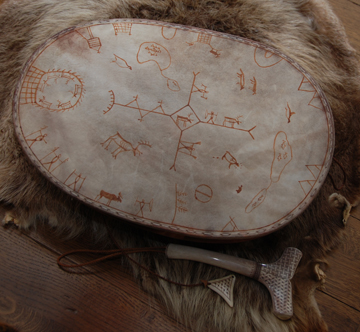Sami handicrafts
Duodji, the Sami word for handicrafts/applied art, has a long and illustrious history. Handicraft has been influenced by the need to survive in a harsh arctic environment (production of clothes to keep warm and weapons to hunt with) and the nomadic nature of the Sami (leading to rounded shapes so as not to hurt reindeer), but have also been influenced latterly by the tourist market and materials from further afield. All members of the family could produce handicrafts and regional variation in handicrafts reflect ethnic identity.

Traditionally art with a purpose
The Sami and their ancestors have dwelt in the harsh arctic environment of Fennoscandia for thousands of years. That would only have been possible with garments to keep warm, weapons that enabled them to hunt animals for food, furs and hides, plus many other essential implements. Hence, the very important utilitarian aspect: everything produced had to have a function. However, the duojár's creations such as knives, cups, caps or costumes had to be aesthetically pleasing as well. Duodji is a creative activity with material and intellectual aspects. At one time every Sami family possessed a goavddis or magic drum, the most important tool of the Sami noaidi (shaman). The drum skins were decorated with figures that laid out the Sami worldview with various realms and the creatures that lived in them. The few surviving drums are beautiful.
In earlier days, part of the experiential upbringing of every Sami child was learning duodji. A division of labour is at play with duodji that has its roots in the distant past: women made clothing, shoes, purses, needle kits; men made knives, cups, drums. One additional feature of duodji, which has its origin in the era of reindeer herding: since reindeer herders were nomadic almost everything had to be carried in draught reindeer packs, and that meant that items had to be well rounded and smooth so as not to hurt the reindeer.
Many of these ancient characteristics are maintained in the creation of handicrafts today, although the utilitarian aspect has fallen away. Duodji may be contrasted with dáidda, ‘art for art’s sake,’ a relatively new concept. Dáidda did not become possible until the stigma of making something without a ‘use’ could be overcome. Ironically, the utilitarian requirement has largely disappeared of late. Many Sami earn a living or supplement their income by creating and selling duodji to outsiders who preserve the items in showcases.
Materials and the cycle of life
The primary aesthetic principle behind duodji (and dáidda) was to make objects out of organic materials and expose them to the elements and, eventually, to decay. Paulus Utsi showed how nature works in his poem ‘Our Life’:
‘Our life is like a ski track on the white open plains. The wind erases it before morning dawns.’
Available materials changed gradually over time. The Sami and their ancestors were never isolated: they traded with others nearby or more at a distance through middlemen. This led to new materials for duodji products; metal tools replaced stone tools and colourful fabrics were imported. Originally, garments were made out of reindeer hides using sinew from the reindeer as thread. All parts of the reindeer were used. Today one might speak of native or borrowed raw materials, the former including reindeer antlers and other bones, wood of deciduous trees, especially birch, burls of birch and other wood (round outgrowths used for cups, bowls and even drums), birch bark, birch roots, leather, especially from reindeer, and pewter thread; and the latter including metal for knife blades and silver for dress ornamentation. Some items were made of both, e.g. colourful, woven bands out of foreign fabric but with Sami design and colours.
Regional variation
Duodji handiwork often varies depending on what part of Samiland it comes from. The costumes have different colour schemes – some quite ornate (Kautokeino), others less so (Tana) – and thus become markers of ethnic identity. Knife sheaths with a gentle curve are more common in the south; those with a sharper curve are usually from the north.
Further reading:
- H. Gaski, Sami Culture in a New Era, (Kárášjohka: Davvi Girji, 1997).
- P. Laiti, P. ‘I respect the skill and heritage of my ancestors’, in E. Helander, and K. Kailo, eds., No Beginning, No End: The Sami Speak Up. (Edmonton: Canadian Circumpolar Institute, 1998).